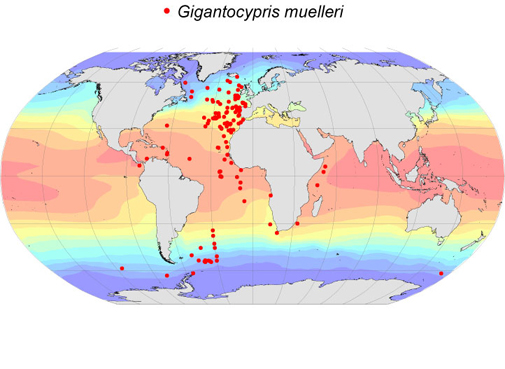Notes
284 records
This large deep mesopelagic-bathypelagic myodocopid is reported to have a very widespread distribution in the Atlantic, but there are few records from other oceans. Poulsen (1962) recorded five Gigantocypris species, but only G. dracontovalis, a small abyssopelagic species has also been reported from the Atlantic. However, Discovery material from the Atlantic includes a few very large specimens about 30mm in length, a size consistent with G. agassizi. Skogsberg’s original description is of Southern Ocean material and hence this is likely to be the type form. Tibbs (1965) reported that G. muelleri has an extensive range in the Southern Ocean based on EltaninHowever, he but did not publish any positional data nor have we been able to locate any records of Tibbs' data. It seems extraordinary that such a large and conspicuous species has been so poorly reported. The Southern Ocean forms are appreciably larger then Atlantic specimens, so it has to be left open whether the Atlantic specimens are indeed G, muelleri. Its reported range is 64°S to 63°N. But, it tends to be more abundant at higher latitudes. It bathymetric range in the North Atlantic is 600-1500m, but there is some evidence for ontogenetic movements, since the shallower records are mainly juveniles and the deeper are adults. The live coloration of adults is predominantly orange-red, with the reflective naupliar eyes appearing silvery. The very large specimens that are probably a different, if not new species, were colourless. Specimens are very watery and are seldom collected undamaged. The species maintain neutral buoyancy by reducing the sulphate content of their haemolymph, and this is probably the functional reason for their wateriness. The length data does not include all the specimens collected, because this is a fragile species that is often damaged in samples. The measurements give below are based on good material collected using an insulated closing cod-end, which enabled specimens to be kept alive in a constant temperature conditions for several days.
| 60°N
|
n
|
Mean mm
|
s.d.
|
Range mm
|
|---|
| Female
|
11
|
14.55
|
0.47
|
13.83-15.50
|
|---|
| Male
|
17
|
12.27
|
0.76
|
11.33-14.00
|
|---|
| A-1
|
7
|
13.18
|
1.34
|
9.33-12.50
|
|---|
| A-2
|
6
|
11.00
|
0.41
|
7.17-8.17
|
|---|
| A-3
|
3
|
|
|
6.25-6.67
|
|---|
| 52°N
|
n
|
Mean mm
|
s.d.
|
Range mm
|
|---|
| Female
|
22
|
13.67
|
1.02
|
12.00-15.50
|
|---|
| Male
|
27
|
11.79
|
0.90
|
10.00-13.50
|
|---|
| A-1
|
17
|
10.48
|
0.76
|
9.67-12.00
|
|---|
| A-2
|
3
|
9.03
|
0.10
|
8.92-9.17
|
|---|
| A-3
|
15
|
7.38
|
0.41
|
6.67-8.08
|
|---|
| A-4
|
8
|
5.95
|
0.41
|
5.33-6.42
|
|---|
| A-5
|
6
|
4.25
|
0.33
|
3.83-4.83
|
|---|
| 44°-50°N
|
n
|
Mean mm
|
s.d.
|
Range mm
|
|---|
| Female
|
58
|
14.15
|
0.49
|
12.8-15.1
|
|---|
| Male
|
70
|
12.22
|
0.57
|
10.3-13.1
|
|---|
| A-1
|
79
|
11.06
|
0.42
|
10.3-12.0
|
|---|
| A-2
|
80
|
9.12
|
0.40
|
8.4-10.0
|
|---|
| A-3
|
117
|
7.42
|
0.26
|
6.8-8.1
|
|---|
| A-4
|
27
|
5.92
|
0.26
|
5.3-6.4
|
|---|
| A-5
|
36
|
4.70
|
0.23
|
4.4-5.2
|
|---|
| Southern Ocean
|
n
|
Mean mm
|
s.d.
|
Range mm
|
|---|
| Female
|
26
|
17.29
|
0.91
|
15.5-18.7
|
|---|
| Male
|
13
|
14.65
|
0.59
|
13.5-15.8
|
|---|
| A-1
|
19
|
13.28
|
1.06
|
11.7-15.2
|
|---|
| A-2
|
11
|
9.80
|
0.26
|
9.3-10.2
|
|---|
| A-3
|
13
|
7.99
|
0.53
|
7.2-9.0
|
|---|
| A-4
|
3
|
|
|
6.1-6.3
|
|---|
| A-5
|
2
|
|
|
3.9-4.4
|
|---|
Bathymetry
Sorry - there are no bathymetry data for this taxon.
Drawings
Sorry - there are no drawings of this taxon.
Outline
Sorry - there is no outline of this taxon.


